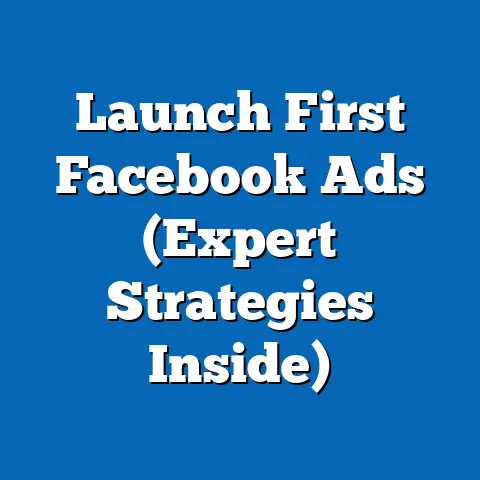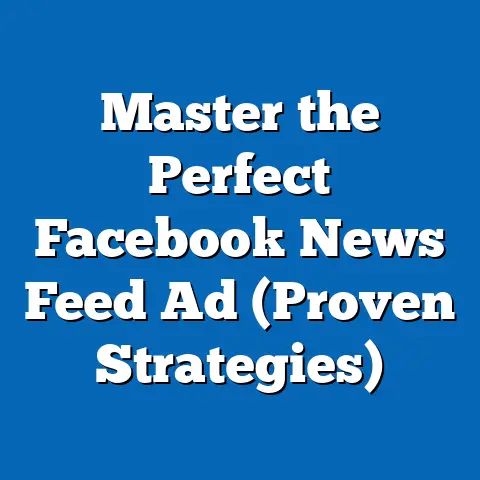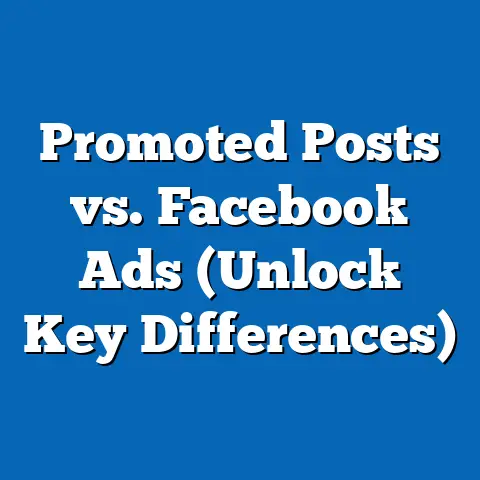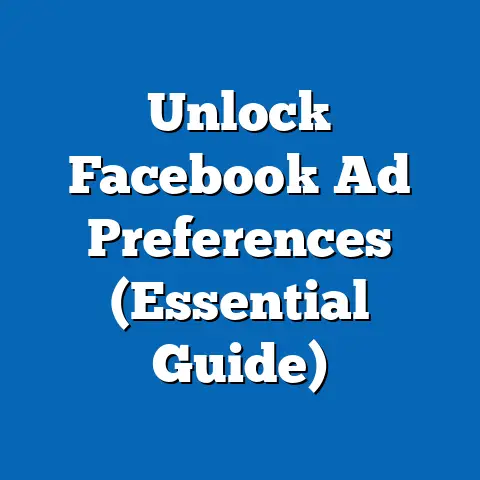Boost Canva Facebook Video Ads (Expert Strategies)
In today’s digital landscape, video content reigns supreme, especially on platforms like Facebook. But let’s be honest, navigating the Facebook ad world can feel like shouting into a crowded room. You’re competing with countless other ads, all vying for the attention of the same scrolling audience. It’s a real challenge for businesses, especially small to medium-sized ones, to create video ads that not only grab attention but also drive meaningful engagement and, ultimately, conversions. Many marketers struggle to produce high-quality videos that resonate with their target audience, often feeling limited by their budget or lack of professional video editing skills.
That’s where Canva comes in. I’ve personally seen how this accessible and user-friendly tool can empower businesses to create engaging Facebook video ads that stand out from the noise and deliver measurable results. In this guide, I’ll share my expert strategies for boosting your Canva Facebook video ads, helping you overcome the common challenges and achieve your marketing goals. From crafting compelling storylines to optimizing for Facebook’s algorithm, I’ll walk you through the steps to create videos that not only look great but also perform exceptionally well.
Understanding the Power of Video Ads on Facebook
Why are video ads so crucial for Facebook marketing? The answer lies in their ability to captivate and engage audiences in a way that static images or text simply can’t match. Video allows you to tell a story, showcase your product in action, and connect with viewers on an emotional level.
The data speaks for itself. Studies consistently show that video content significantly increases engagement and conversion rates compared to other forms of advertising. For instance, a study by HubSpot found that 54% of consumers want to see more video content from a brand or business they support. Moreover, video ads on Facebook have been shown to generate higher click-through rates (CTR) and lower cost-per-click (CPC) compared to static image ads.
Video’s power lies in its ability to enhance brand storytelling and foster emotional connections with audiences. Instead of just telling people about your product or service, you can show them how it solves their problems, improves their lives, or simply makes them feel good. This is especially important on Facebook, where users are often looking for authentic and relatable content.
Key Takeaway: Video ads are essential for Facebook marketing because they increase engagement, boost conversion rates, and allow you to connect with your audience on a deeper level.
Why Choose Canva for Video Ad Creation
Now, let’s talk about Canva. While professional video editing software can be powerful, it often comes with a steep learning curve and a hefty price tag. Canva offers a refreshing alternative: an accessible and user-friendly tool that empowers marketers and business owners to create stunning video ads without needing years of design experience or a massive budget.
I remember when I first started creating video ads, I was intimidated by the complexity of traditional video editing software. Canva was a game-changer for me. Its intuitive interface, extensive library of templates, and drag-and-drop functionality made the entire process incredibly easy and efficient.
Here’s what makes Canva such a great choice for video ad creation:
- User-friendly Interface: Canva’s drag-and-drop interface is incredibly intuitive, making it easy for anyone to create professional-looking videos, even without prior design experience.
- Extensive Template Library: Canva offers a vast library of pre-designed video templates for various industries and purposes. These templates provide a great starting point and can be easily customized to fit your brand.
- Affordable Pricing: Canva offers a free plan with plenty of features for basic video creation. For more advanced features and access to a larger library of assets, the Pro plan is very reasonably priced.
- Collaboration Features: Canva allows you to collaborate with your team members on video projects, making it easy to share ideas and get feedback.
- Mobile App: Canva’s mobile app allows you to create and edit videos on the go, giving you the flexibility to work from anywhere.
The advantages of using Canva over traditional video editing software are clear, especially for those with limited design experience or budget constraints. Canva democratizes video creation, making it accessible to everyone and empowering businesses of all sizes to create engaging and effective video ads.
Key Takeaway: Canva is an accessible, user-friendly, and affordable tool that empowers marketers and business owners to create stunning Facebook video ads without needing extensive design experience or a large budget.
Expert Strategies for Boosting Your Canva Facebook Video Ads
Now, let’s dive into the expert strategies that will help you boost your Canva Facebook video ads and achieve your marketing goals.
Crafting Compelling Storylines
The heart of any successful video ad is a compelling storyline. People are naturally drawn to stories, and a well-crafted narrative can capture their attention, evoke emotions, and leave a lasting impression.
Think about the brands that resonate with you the most. What makes them stand out? Chances are, they’re telling stories that connect with you on a personal level. The same principle applies to video ads. Instead of just focusing on the features of your product or service, focus on the benefits and how it can improve your audience’s lives.
Here are some tips for crafting compelling storylines for your Canva Facebook video ads:
- Identify Your Target Audience’s Pain Points: What are the challenges and frustrations that your target audience faces? How can your product or service solve their problems?
- Create a Narrative with a Clear Beginning, Middle, and End: Your video should have a clear structure that guides viewers through the story. Start by introducing the problem, then present your product or service as the solution, and end with a call to action.
- Focus on the Benefits, Not Just the Features: Instead of just listing the features of your product or service, focus on the benefits and how they can improve your audience’s lives.
- Evoke Emotions: Use visuals, music, and storytelling to evoke emotions in your audience. Make them feel happy, excited, inspired, or even a little nostalgic.
- Keep it Concise: Attention spans are short, especially on social media. Keep your video ads concise and to the point. Aim for a length of 15-30 seconds.
Example: Let’s say you’re selling a productivity app. Instead of just showing the app’s features, you could create a video that tells the story of someone who is struggling to manage their time and is feeling overwhelmed. Then, you introduce your app as the solution, showing how it helps them get organized, prioritize tasks, and achieve their goals.
Key Takeaway: Crafting a compelling storyline is crucial for capturing your audience’s attention, evoking emotions, and leaving a lasting impression. Focus on the benefits of your product or service and how it can improve your audience’s lives.
Utilizing Canva’s Features
Canva is packed with features that can enhance your video ads and make them more visually appealing. Let’s explore some of the key features and how to use them effectively:
- Animations: Canva offers a variety of animation styles that can add movement and excitement to your videos. Use animations to highlight key elements, create transitions, or simply add a touch of visual flair.
- Transitions: Transitions help you seamlessly connect different scenes in your video. Canva offers a range of transition styles, from simple fades to more dynamic wipes and zooms.
- Text Overlays: Text overlays can be used to add captions, headlines, or calls to action to your videos. Choose fonts that are easy to read and align with your brand’s visual identity.
- Music and Sound Effects: Music and sound effects can significantly enhance the emotional impact of your videos. Canva offers a library of royalty-free music and sound effects that you can use in your projects.
- Video Editing Tools: Canva offers a range of video editing tools, such as trimming, cropping, and resizing, that allow you to fine-tune your videos and optimize them for Facebook’s platform.
Step-by-Step Guide:
- Choose a Template: Start by selecting a video template that aligns with your brand and message.
- Add Your Footage: Upload your own video clips or choose from Canva’s library of stock footage.
- Customize the Design: Customize the template by adding your own text, images, and branding elements.
- Add Animations and Transitions: Use animations and transitions to add movement and visual interest to your video.
- Add Music and Sound Effects: Enhance the emotional impact of your video by adding music and sound effects.
- Optimize for Facebook: Ensure that your video is optimized for Facebook’s platform by using the correct dimensions and file format.
Example: Let’s say you’re creating a video ad for a new restaurant. You could use animations to highlight your menu items, transitions to smoothly connect different scenes of your restaurant, and text overlays to display your address and phone number.
Key Takeaway: Canva offers a range of features that can enhance your video ads and make them more visually appealing. Experiment with animations, transitions, text overlays, music, and sound effects to create videos that capture attention and engage your audience.
Optimizing for Facebook’s Algorithm
Creating a great video is only half the battle. To ensure that your video ad reaches the right audience and achieves its goals, you need to optimize it for Facebook’s algorithm.
Facebook’s algorithm is constantly evolving, but there are some key factors that consistently influence video ad performance:
- Video Length: Shorter videos tend to perform better on Facebook. Aim for a length of 15-30 seconds.
- Video Format: Facebook recommends using the MP4 or MOV file format for video ads.
- Thumbnail Selection: Your video’s thumbnail is the first thing that people see, so choose a visually appealing and relevant image that will grab their attention.
- Captions: Adding captions to your videos makes them accessible to a wider audience and can also improve engagement rates. Many people watch videos on Facebook with the sound off, so captions ensure that they can still understand your message.
- Call to Action: Include a clear and compelling call to action in your video ad. Tell people what you want them to do, whether it’s visiting your website, signing up for your newsletter, or making a purchase.
Pro Tip: Use Facebook’s Ad Library to research what types of video ads are performing well in your industry. This can give you valuable insights into what resonates with your target audience.
Example: Let’s say you’re running a video ad for an online course. You could optimize it for Facebook’s algorithm by keeping it under 30 seconds, using a visually appealing thumbnail, adding captions, and including a clear call to action that encourages people to sign up for the course.
Key Takeaway: Optimizing your video ads for Facebook’s algorithm is crucial for ensuring that they reach the right audience and achieve their goals. Pay attention to video length, format, thumbnail selection, captions, and call to action.
A/B Testing Your Video Ads
A/B testing, also known as split testing, is the process of comparing two versions of your video ad to see which one performs better. This is an essential step for refining your video ads and maximizing their effectiveness.
I’ve personally seen how A/B testing can lead to significant improvements in video ad performance. By testing different elements, you can identify what resonates best with your target audience and optimize your videos accordingly.
Here are some elements that you can A/B test in your Canva Facebook video ads:
- Visuals: Test different images, video clips, and animations to see which ones capture attention and engage viewers.
- Messaging: Test different headlines, captions, and calls to action to see which ones resonate best with your target audience.
- Audience Targeting: Test different audience targeting options to see which ones are most likely to convert.
- Video Length: Test different video lengths to see which ones perform best.
- Placement: Test different ad placements on Facebook to see which ones generate the most engagement.
How to A/B Test:
- Create Two Versions of Your Video Ad: Create two versions of your video ad that are identical except for the element that you want to test.
- Set Up Your Facebook Ad Campaign: Set up your Facebook ad campaign and target your desired audience.
- Run Your Ads: Run your ads for a set period of time, such as a week or two.
- Analyze the Results: Analyze the results of your A/B test to see which version of your video ad performed better.
- Implement the Winning Version: Implement the winning version of your video ad and continue to test other elements to further optimize its performance.
Example: Let’s say you’re running a video ad for a new product. You could A/B test two different headlines to see which one generates more clicks. You could also A/B test two different calls to action to see which one leads to more conversions.
Key Takeaway: A/B testing is an essential step for refining your video ads and maximizing their effectiveness. Test different elements, such as visuals, messaging, and audience targeting, to see what resonates best with your target audience.
Measuring Success and Iterating
Creating and launching your Canva Facebook video ads is just the beginning. To truly maximize your return on investment, you need to track their performance, analyze the data, and iterate on your strategies based on what you learn.
Facebook Insights is a powerful tool that provides valuable data about your video ad performance. You can use it to track key performance indicators (KPIs) such as:
- Engagement Rate: The percentage of people who interacted with your video ad, such as liking, commenting, or sharing.
- Click-Through Rate (CTR): The percentage of people who clicked on the link in your video ad.
- Conversion Rate: The percentage of people who took a desired action after watching your video ad, such as making a purchase or signing up for your newsletter.
- Cost Per Click (CPC): The amount you paid for each click on your video ad.
- Cost Per Conversion (CPC): The amount you paid for each conversion generated by your video ad.
- Reach: The number of unique people who saw your video ad.
- Impressions: The number of times your video ad was displayed.
- Video Completion Rate: The percentage of people who watched your video ad to completion.
By monitoring these KPIs, you can gain valuable insights into what’s working and what’s not. For example, if your engagement rate is low, you may need to revise your visuals or messaging. If your CTR is low, you may need to improve your call to action. And if your conversion rate is low, you may need to optimize your landing page or product offering.
The key is to use data to inform your future video ad strategies and iterate on your existing campaigns for continuous improvement. Don’t be afraid to experiment with different elements and see what works best for your target audience.
Example: Let’s say you’re running a video ad for a new product and you notice that your video completion rate is low. This could indicate that your video is too long or that it’s not engaging enough. You could try shortening your video or adding more visually appealing elements to capture viewers’ attention.
Key Takeaway: Tracking the performance of your Canva Facebook video ads is crucial for maximizing your return on investment. Use Facebook Insights to monitor key performance indicators and iterate on your strategies based on what you learn.
Conclusion
In conclusion, boosting your Canva Facebook video ads requires a combination of creativity, strategy, and data analysis. By crafting compelling storylines, utilizing Canva’s features effectively, optimizing for Facebook’s algorithm, A/B testing your ads, and measuring your results, you can create video ads that capture attention, engage your audience, and drive meaningful results.
I encourage you to take action by integrating these strategies into your marketing efforts. Start by identifying your target audience’s pain points and crafting a compelling storyline that resonates with them. Then, use Canva’s features to create visually appealing videos that capture attention and evoke emotions. Optimize your videos for Facebook’s algorithm and A/B test different elements to see what works best. Finally, track your results and iterate on your strategies based on what you learn.
By adopting these expert strategies and utilizing Canva, you can effectively boost your Facebook video ads and achieve your marketing goals. So, go ahead and start creating amazing video ads that will help you stand out from the competition and connect with your audience on a deeper level.




